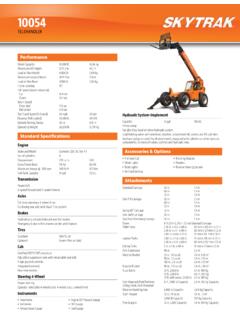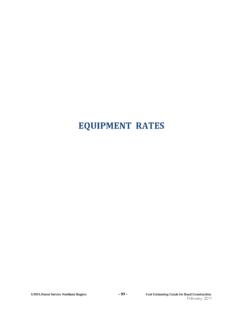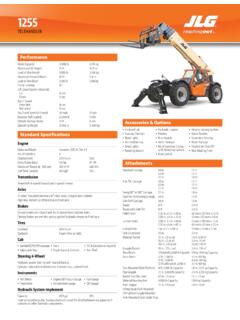Transcription of Piles Capacity - Reference Manual - hetGE
1 Piles Capacity Reference ManualhetGEhetGEgeotechnics on the goPiles Capacity Reference ManualApril 3, 2013 Version: LLC Moscow Virginia Istanbul E W Capacity is the Estimator for Deep Foundation Designers , which is built to be employed by geo-professionals for investigating the undrained pile bearing Capacity of cast-in-place bored Piles (also referred as drilled shafts) constructed in various soil profiles consisting of Granular layers (sand, gravel), Cohesive layers (clay, silt) and IGM-Rock strata (intermediate geotechnical materials, weak rocks).There are two versions of Piles Capacity for the most popular mobile and desktop platforms: iOS version running on iPhones, iPads, iPod Touches running system version or higher, XLS version running on Windows-PC with Microsoft Excel 2003 or higher user interfaces of these software are designed to be straightforward with no need for reading a user guide.
2 In the iOS version, almost all labels visible on the screen can be tapped to carry out particular functions and modifications. Here are some examples: Tapping on the label with FoS on the main screen, toggles between different set of safety factors; To changes the soil type of a layer, just tap on its soil type label, To set the values of the soil parameters, just tap on them to bring up a numerical type pad, To change thickness of any layer, just drag the circular handle located at the bottom of the layer. Please note that layer thicknesses are rounded by meters (SI units) or 1 feet (US units) by design of the touch driven versions of Piles Capacity share the same unique estimation engine which is: designed with speed and simplicity to overcome complexity of the problem at hand quickly, prepared by an extended research of latest literature on the topic.
3 Completely open with full references given in following b l e o f C o n t e n t s General Approach 5 Cohesive Soil Deposits 6 Shaft Friction in Cohesive Material 6 Tip Resistance in Cohesive Material 7 Granular Soil Deposits 8 Shaft Friction in Granular Material 8 Tip Resistance in Granular Material 9 Weak Rocks and IGMs 10 Shaft Friction in Weak Rocks and IGMs 10 Tip Resistance in Weak Rocks and IGMs 11 Diameter Reduction Coefficient in Weak Rocks and IGMs 12 Tip Resistance Correction 13 Bibliography 16 Epilogue 17
4 Piles Capacity Reference Manual 4 General ApproachLet s start with simple clarifications for the sake of establishing a common understanding of the terms which are going to be used frequently throughout this document. Ultimate and allowable compressive load bearing capacities of bored Piles (drilled shafts) with elements for skin friction and tip resistance are defined below:Qu=Qs+Qb WQa=qs AsFSs+qb AbFSb W(1)where,Quultimate bearing capacityQaallowable bearing capacityWsubmerged pile weightFSs,FSbfactor of safety for skin friction and tip resistance, respectivelyQsultimate skin frictionqsultimate unit skin frictionAsarea of shaft surfaceQbultimate tip resistanceqbultimate unit tip resistanceAbarea of pile basePlease note that limiting values for ultimate skin friction and tip resistance, which will be given in the following chapters, are derived from Budhu (2011), pp.
5 544 545 except where noted. Piles Capacity Reference Manual 5 Cohesive Soil DepositsFor cohesive soil deposits, such as clays and silts which are modestly characterized by the undrained shear strength parameter cu, the evaluation of shaft friction and tip resistance is explained in following Friction in Cohesive MaterialThe friction acting along the pile shaft in a cohesive layer can simply be estimated by:qs= cu, avg(3)where, factor of adhesioncu, avgaverage undrained cohesion of soil layerFactor of adhesion is evaluated as: = cu/pa cupa for <cu/pa (4)where,paatmospheric pressure (101 kPa or psi)General notes for shaft friction in cohesive soil layers: Reference for Eq.
6 3 4: O Neill and Reese (1999), pp. B-27 28. Ultimate unit skin friction qs has a limiting value of 380 kPa or 55 psi in cohesive soils. Piles Capacity Reference Manual 6 Tip Resistance in Cohesive MaterialThe tip resistance of a pile resting on a cohesive layer is generally taken as:qb=Nc cu(5)where,Ncbearing Capacity factorcuundrained cohesion at the pile toeBearing Capacity factor Nc is:Nc= hpenet. 3B6+ (6)where, of penetration into the layerGeneral notes for tip resistance in cohesive soil layers: Reference for Eq. 5 6: Fleming et al. (2009), Ultimate unit tip resistance qb has a limiting value of 4000 kPa or 580 psi in cohesive soils. Piles Capacity Reference Manual 7 Granular Soil DepositsFor granular soil deposits, such as sands and gravels, the estimation of shaft friction and tip resistance are presented in the following Friction in Granular MaterialThe friction acting along the pile shaft in a granular layer can be derived from:qs=K v, avg tan (7)where,Kcoefficient of lateral earth pressure v, avgaverage vertical effective stress along the layer effective shear resistance angle of soil layerCoefficient of lateral earth pressure K is : K= 1 sin ()(8)General notes for shaft friction in granular soil layers: Reference for Eq.
7 7 8: Tomlinson and Woodward (2008), 171. Ultimate unit skin friction qs has a limiting value of 200 kPa or 29 psi in granular soils. Piles Capacity Reference Manual 8 Tip Resistance in Granular MaterialThe tip resistance of a pile resting on a granular layer is estimated by:qb=Nq v(9)where,Nqbearing Capacity factor (function of shear resistance angle, see Table 1) vvertical effective stress at the pile toeTable 1: Bearing Capacity factors for different shear resistance angles (NAVFAC (1986) p. Nq26283031323334353637383940581012141721 253038436072 Ultimate unit tip resistance qb can be also calculated using the SPT number of the bearing stratum at the pile toe. This value should be an average representing 3B thickness beneath the pile toe.)
8 Qb= NSPT (qb in kPa)qb= NSPT (qb in psi)(10)General notes for tip resistance in granular soil layers: Reference for Eq. 9: Prakash and Sharmad (1990), pp. 221 222. Reference for Eq. 10: O Neill and Reese (1999), p. B-22. Ultimate unit tip resistance qb has a limiting value of kPa or 625 psi as advised by Mullins (2006) Piles Capacity Reference Manual 9 Weak Rocks and IGMsFor weak rock layers or IGMs (intermediate geomaterials), some simple methods for the estimation of shaft friction and tip resistance are presented in the following Friction in Weak Rocks and IGMsThe shaft friction along the part of the pile socketed in weak rock or IGMs can be approximated by:qs= c(11)where, cunconfined compressive strength of the weak rock or IGM factor of adhesion using the empirical data from field tests (Figure 1)Figure 1.
9 Relationship between unconfined compressive strength of rock and factor of adhesion (Wyllie, 1999; after Williams and Pells, 1981, courtesy of Research Journals. National Research Council Canada). u(r): rock unconfined compressive strength; ult: ultimate side-wall shear , the shaft friction equation becomes:qs= c() (12) Piles Capacity Reference Manual 10 General notes for shaft friction in weak rock: Reference for Eq. 11 12 and Figure 1: Wyllie (1999), pp. 258 263. Ultimate unit skin friction qs has a limiting value of around 10 MPa or 1450 psi since the adhesion factor converges to for an extreme unconfined strength of 100 MPa as illustrated in Figure 1 for weak rocks and Resistance in Weak Rocks and IGMsThe tip resistance of a pile socketed in weak rock or IGMs can be approximated with the following formula which uses a wide range of field test data (Figure 2).
10 Qb= c() (13)Figure 2: Relationship between compressive strength of weak rock and end bearing Capacity (Zhang, 2004; after Zhang and Einstein, 1998) Piles Capacity Reference Manual 11 General notes for tip resistance in weak rock: Reference for Eq. 13: Zhang (2004); after Zhang and Einstein (1998), pp. 211 219. Ultimate tip resistance qb has a limiting value of 50 MPa or 7250 psi for weak rocks and IGMs as suggested by Figure 2. But generally the ultimate bearing Capacity of rock sockets are actually limited by the compressive strength of reinforced-concrete inside the shaft. We strongly recommend not to rely only on these simple approximations for pile bearing Capacity in rocks, since there are many other methods which take into consideration other crucial rock parameters such as the RQD, shaft roughness and the fracture structure at the rock socket etc.


